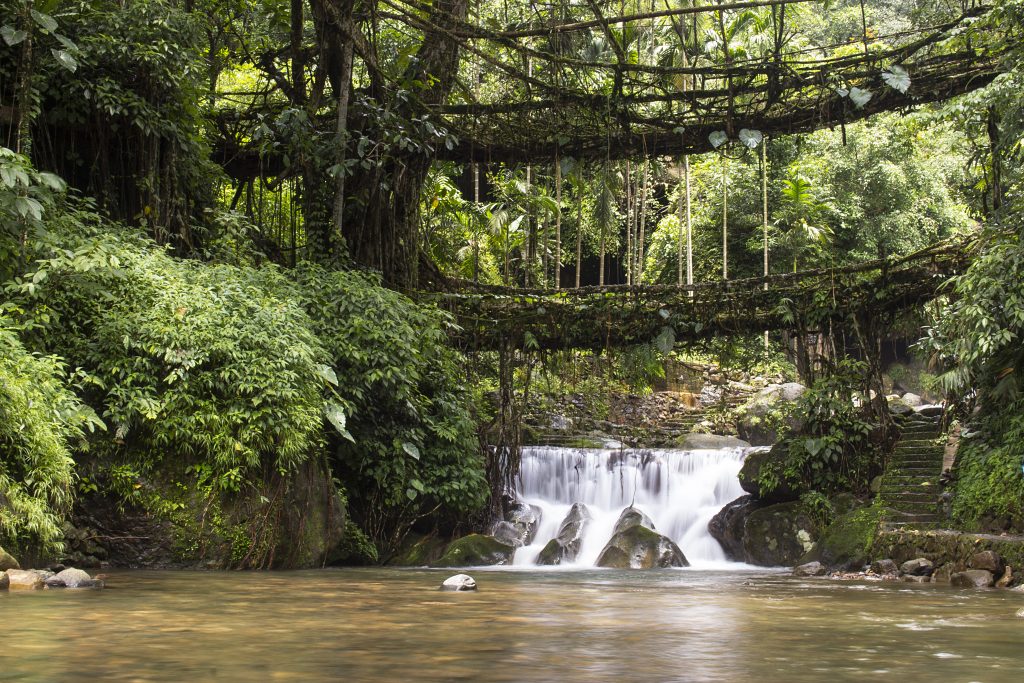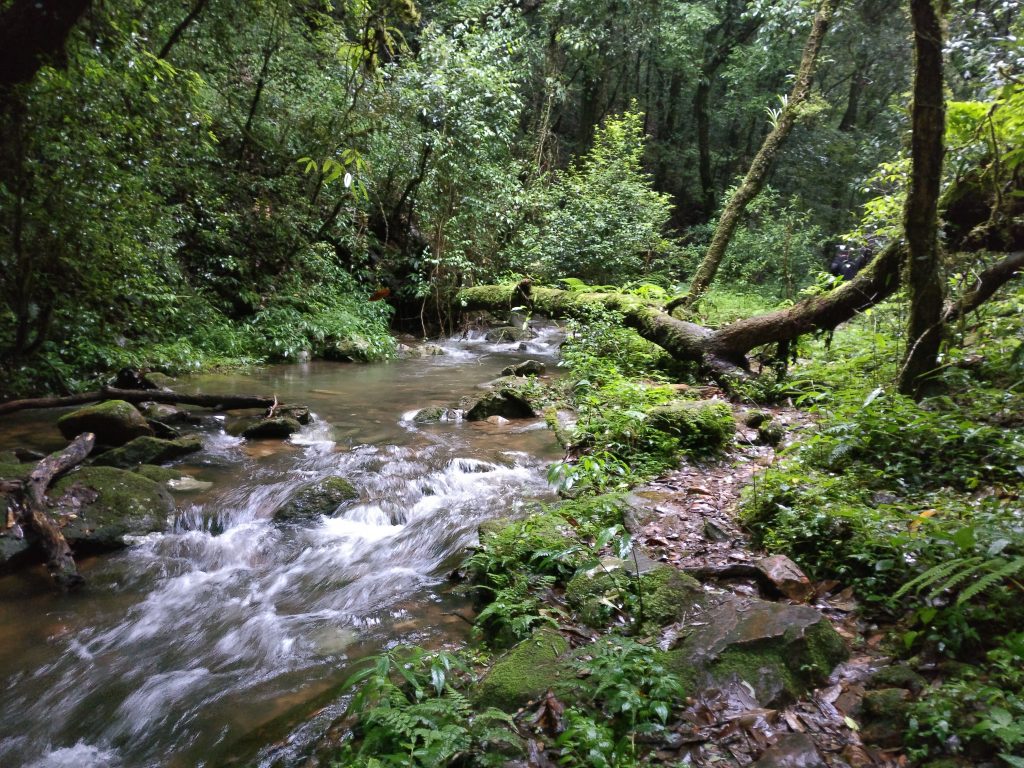By Advaita Raut
Fondly termed as ‘the abode of the clouds’, this magical northeastern state lives up to its name and how. From wind-sculpted cliffs and a vibrant culture, to cascading rice terraces and gossamer waterfalls, Meghalaya is nature’s gift that keeps giving.
They say, to truly experience the magic of Meghalaya, you must visit it twice. Once, during the monsoons, when rains spectacularly lash this rustic land, deepening its verdure with every shower; a time when waterfalls gush with a renewed fervor, and the land awakens to the call of the skies. The other time is during the winters, when the place holds you in a rapture unlike any other. Warmed beautifully by the mellow winter sun, vast, gold fields yawn lazily under a bright blue halo of skies. All around the year however, the East Khasi and West Jaintia hills roll endlessly and languidly, beckoning you to explore hidden corners.
Here is a list of places you must add to your itinerary on your visit to Meghalaya.
Double-Decker Living Root Bridge
Deep within the rain-soaked interiors of Cherrapunjee, one of India’s wettest places, is Meghalaya’s most iconic attraction. Reserve a day to soak in the beauty of this quirk of nature, woven together by time and humankind. Begin your trek from the village of Nongriat, where the scenic trail takes you through a series of enchanting landscapes – from picturesque cottages surrounded by flowering trees, to verdant canyons that drop with beautiful abandon. Some 3000-odd steps and two small bridges later, you will chance upon this astounding landmark.
These bridges lie wonderfully suspended one above another, even as limpid pools of cool mountain water glimmer quietly below. These gnarled, age-old roots of rubber trees were meshed together by the Khasi people years ago, and still exist, strong and unflinching as ever. After you test out the bridges for yourself, relax by the natural pools below. Dip your feet in the water, and wait patiently as pond fish nibble gently at your tired soles. After a well-deserved break, hike up another hour to the Rainbow Falls, or begin the arduous journey back to the trailhead.
Krang Shuri Waterfall
This exquisite hidden gem lies nestled in the lap of the West Jaintia hills, fiercely protected by verdant forests. A small trail slices through the dense greenery, dipping gently to reveal a gorgeous pond of dreamy blue waters. A silky curtain of water holds you in rapture as it tumbles down a stone lip. Admire these falls from a vantage on one of the boulders that encircle the pool, or simply jump into the crystal clear waters with childlike abandon. However you choose to enjoy the beauty of the falls, Krang Shuri will stay imprinted in your memory.
Shnongpdeng
Another West Jaintia treasure is the scenic village of Shnongpdeng, an enclave of idyll not far from the Bangladesh border. In fact, as you traverse the winding roads that lead you to this village, there are several viewpoints along the way that offer sweeping views of Bangladesh’s distant floodplains. Getting to Shnongpdeng is an adventure in itself. A rocky drive lined with tall rubber trees ends at the approach of a long suspension bridge. As you cross the suspension bridge, stop halfway and admire the aquamarine brilliance of the Umngot River that flows right underneath.
On the other end of the bridge are campsites where you can rest the night. If you’re lucky to be here on a full moon evening, you will be rewarded with surreal views of the river and the village as they both sleep under the moon’s pearlescent glow. The next morning, indulge in kayaking along the river, or engage in a thrilling cliff diving activity. Those who don’t wish to spend the night can visit the Dawki River instead, located not too far from Shnongpdeng. Dawki is especially famous for its clear, glassy waters. If you look closely, the boats that ply the river seem to almost float on the surface.
Mawsmai Caves
Past Cherrapunjee’s vast, sweeping grasslands, these splendid limestone caves evoke much mystery and delight. Carved and sculpted by the whims of underground water, these caves form part of a much larger cave system that is only open to experienced spelunkers. A 150-meter (492-foot) long part of the cave however, is reserved for tourists to explore. For a paltry sum, you can catch a glimpse of this cavernous beauty as it twists and turns along a puzzling route. Be prepared to slide, duck, and squeeze through narrow openings as you navigate through the cave’s damp and dark depths, past stalactites and odd rock formations that you are certain to encounter. Those uncomfortable in tight spaces need not fret, as the entire journey is over in all of ten minutes, and occasional slivers of sunlight offer immense respite.
Mawphlang Sacred Forest
Meghalaya is a land brimming with legends and stories of a tribal past, where elements of nature were deified and worshiped. Some of these legends still hold true today, and you can learn and experience more about them at the Mawphlang Sacred Forest. Arched under clear blue skies, this beautiful forest, replete with babbling brooks and native trees is a revered landmark among East Khasi tribes. A local guide helps you maneuver through this striking maze of green, where the locals once conducted animal sacrifices and rituals to appease the forest deity known as labasa. Stone cairns and menhirs along the way signal respect to passed ancestors, whereas moss-covered stone slabs indicate the site of sacrificial rituals. Besides sacrificial significance, the forest abounds with millennia-old trees and flowering plants, from wild mushrooms and rudraksha trees, to medicinal plants and luscious-looking poisonous fruits. Needless to say, the forest is tethered by a sacrosanct rule that every tourist must abide by. Those who enter the forest are forbidden to carry anything out of the forest – be it a stone, a leaf, or even a twig; else be prepared to meet an ill-fated outcome.
Shillong
This utterly picturesque mountain town is perhaps the most recognizable icon of the state of Meghalaya, a cosmopolitan capital brimming with charm and culture. From the serene Umiam Lake and the labyrinthine Don Bosco Museum, to the city’s towering cathedral, Shillong is home to several fascinating attractions. While you’re here, also be sure to experience its vibrant cafe culture. One of its most popular spots is Dylan’s Cafe, a beautiful, light-filled space dedicated to Bob Dylan. Come evening, stroll the busy streets that slice through Police Bazaar, a bustling neighborhood market for all and sundry. Shop for northeastern spices and handicrafts, or winter wear and souvenirs. This is also a terrific place to try street food; whether it is the fragrant Jadoh rice – a Khasi specialty flavored with spices and accompanied by meat, steaming hot momos, or Dohkhlieh, a local pork salad garnished with onions and chillies. End your jaunt with the sweet jalebi, a deep-fried pretzel dunked in sugar syrup – at the Delhi Misthan Bhandar.







Excellent article, beautifully described ! More power to your pen…